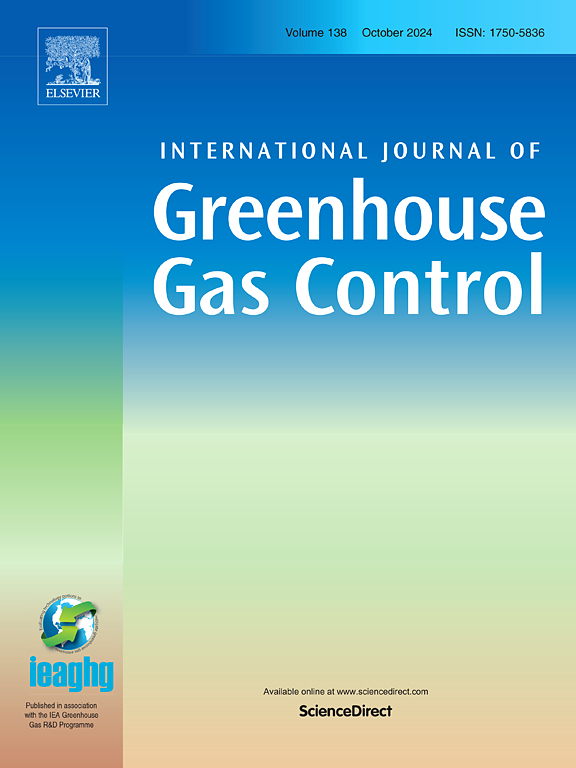Optimizing the management of quarry fines for on-site carbon removal: Implications of grain size and mineralogy on CO2 mineralization
IF 5.2
3区 工程技术
Q2 ENERGY & FUELS
International Journal of Greenhouse Gas Control
Pub Date : 2025-03-18
DOI:10.1016/j.ijggc.2025.104344
引用次数: 0
Abstract
Weathering of basaltic quarry fines can enable quarries to remove CO2 by optimizing the management of underutilized rock fines. In this study, basaltic fines from two quarries in Scotland are used as potential feedstocks for ERW. Using column experiments, fines from both sites were placed into columns as layers with varying thicknesses (1 cm and 5 cm) and grain sizes (bulk and <100 μm). Fines were saturated (≈60 % pore water) and exposed to ambient UK conditions (10 °C, 0.04 % CO2) and accelerated carbonation conditions (50 °C, 20 % CO2). Quarry site 1 experienced negligible increases in TIC within bulk fines under ambient conditions, yet fines <100 μm experienced carbonation equivalent to 440 g CO2/m2/yr. However, the total inorganic carbon content (TIC) nearly doubled in the bulk fines from quarry site 2 (5 cm) under ambient conditions, equivalent to 570 g CO2/m2/yr. In the sieved fines from the same site the TIC content nearly tripled, equivalent to 1330 g CO2/m2/yr. At site 2, if the bulk fines could be deposited over 0.8 km2 of land in 5 cm thicknesses, approximately 460 t CO2/yr could be sequestered with minimal management practices in place. Using fresh fines that have not previously weathered in stockpiles is important for maximizing the carbon dioxide removal potential. Despite higher carbon offsets within the sieved material, the energy and cost required to crush rock from bulk to <100 μm is not economically feasible, as it exceeds the value of carbon which it could be sold for.
优化采石场矿粉的现场碳去除管理:粒度和矿物学对CO2矿化的影响
玄武岩采石场细岩的风化作用可以使采石场通过优化对未充分利用的细岩的管理来去除二氧化碳。在这项研究中,来自苏格兰两个采石场的玄武岩粉被用作潜在的废石原料。通过柱状实验,将两个地点的细粒作为不同厚度(1 cm和5 cm)和粒度(散装和100 μm)的层放入柱状中。颗粒被饱和(≈60%孔隙水),暴露于英国环境条件(10°C, 0.04% CO2)和加速碳化条件(50°C, 20% CO2)。在环境条件下,采石场1在散装细粉中TIC的增加可以忽略不计,但细粉<;100 μm经历了相当于440 g CO2/m2/yr的碳化。然而,在环境条件下,来自采石场2(5厘米)的大块细粉的总无机碳含量(TIC)几乎翻了一番,相当于570克二氧化碳/平方米/年。在同一地点的筛分粉中,TIC含量几乎增加了两倍,相当于1330 g CO2/m2/yr。在站点2,如果大块细粒沉积物可以沉积在0.8平方公里的土地上,厚度为5厘米,那么通过最小的管理措施,每年可以封存约460吨二氧化碳。使用之前未在库存中风化的新粉对于最大限度地提高二氧化碳去除潜力非常重要。尽管在筛分材料中有更高的碳补偿,但将岩石从块状破碎到100 μm所需的能量和成本在经济上是不可接受的,因为它超过了碳的销售价值。
本文章由计算机程序翻译,如有差异,请以英文原文为准。
求助全文
约1分钟内获得全文
求助全文
来源期刊
CiteScore
9.20
自引率
10.30%
发文量
199
审稿时长
4.8 months
期刊介绍:
The International Journal of Greenhouse Gas Control is a peer reviewed journal focusing on scientific and engineering developments in greenhouse gas control through capture and storage at large stationary emitters in the power sector and in other major resource, manufacturing and production industries. The Journal covers all greenhouse gas emissions within the power and industrial sectors, and comprises both technical and non-technical related literature in one volume. Original research, review and comments papers are included.

 求助内容:
求助内容: 应助结果提醒方式:
应助结果提醒方式:


